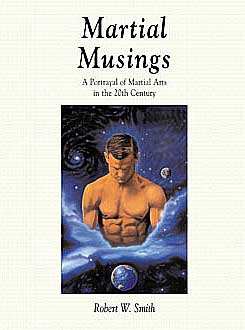Martial Musings:
A portrayal of martial arts in the 20th century
by Robert W. Smith
Via Media Publishing Company, $39.95
ISBN 1893765008
Review by Deborah Klens-Bigman
 Robert Smith's Martial Musings is a ramble through
martial arts practice in the US, Taiwan and Japan
covering nearly all of the 20th century. We follow
Smith as he tries his hand first at boxing, then judo,
moving on to taiji and xingyi (Chinese boxing). Smith
seems to have met everyone and seen nearly everything
in the course of his study and he has written it all
down here for us. The book is part personal odyssey
in martial arts, part textbook, and part memoir. While
he occasionally departs from the title subject, martial
arts is definitely the axis around which Smith's life
has turned.
Robert Smith's Martial Musings is a ramble through
martial arts practice in the US, Taiwan and Japan
covering nearly all of the 20th century. We follow
Smith as he tries his hand first at boxing, then judo,
moving on to taiji and xingyi (Chinese boxing). Smith
seems to have met everyone and seen nearly everything
in the course of his study and he has written it all
down here for us. The book is part personal odyssey
in martial arts, part textbook, and part memoir. While
he occasionally departs from the title subject, martial
arts is definitely the axis around which Smith's life
has turned.
Smith's writing style is lively and engaging; he's an experienced storyteller.
Much of the book, except for sections that have previously been printed in the
Journal of Asian Martial Arts or elsewhere, has a rambling, non-linear style.
Readers who are used to getting to the point quickly may become impatient. Smith
makes it a journey to get to the heart of the matter, but the scenery is worth
the trip. His digressions often profile a teacher, student or exponent of the
martial art or sport he's discussing. Early in the book, he gives an affectionate
portrait of Jack Johnson, whom Smith describes as "the greatest heavyweight boxer
of all time" and a warm human being as well (p.19). At only one point does a lengthy
digression, entitled "My writers: an interlude" (pages 265-276), where the author
details portions of his career as a writer and interviewer for the Washington
Post and other newspapers, does the book not wind its way back to make a point
regarding martial arts. Though readers with an interest in the subject will find
this section interesting in itself, it does seem out of place for a book entitled
Martial Musings. Smith's writing is filled with clever quotations and original
turns of phrase. Generally speaking, this technique serves the material well.
Unfortunately, however, he uses so many authors' quotations in his introduction
that the reader may fear the entire text is that way. It is not. One gets the
feeling that, having written a tremendously detailed and fascinating martial arts
memoir, Smith suddenly felt unsure of himself. Self-consciousness is certainly
unnecessary here.
Some readers will be surprised (and perhaps disgruntled) by Smith's tendency to
slay any sacred cow he comes across, whether in martial arts, music, life, poetry
or literature (I remained disengaged until he skewered Charlie Parker, claiming
he "ruined" jazz - indeed!). Certainly no one will agree with everything Smith
says. He is sharp in his criticism where he doesn't agree with a style, a technique
or a teacher. Even Ueshiba Morihei comes under scrutiny, and Smith's friend, Donn
Draeger, is raked for not, in Smith's opinion, giving full consideration to Chinese
martial arts in his work. Likewise, Smith is equally lavish in praise and admiration
for masters with whom he trained, including 10th dan judoka Kyuzo Mifune, taiji
legend Zheng Manqing, and teacher Ben Lo.
In the last portion of the book, Smith takes on Hollywood martial art shibboleths,
including Bruce Lee (five years of actual martial arts practice does not, in Smith's
opinion, make Lee a real martial artist, let alone one who could design a credible
style of his own). Stallone, Siegal, and other well-known celluloid heroes get
similar treatment. (Lest we miss the point, this section is entitled "The Bogus:
Hollywood.")
Smith reserves the large part of his ammunition in this part of the book for an
apparently favorite target, self-proclaimed "martial arts masters" and self-aggrandizing
students. He tells numerous stories of "masters" who challenged him and were later
manhandled either by Smith or his students, and of students who appeared self-effacing,
but were really out for whatever they thought they could steal (they couldn't).
Throughout the book, Smith maintains a sense of humility, repeatedly describing
himself as only a "middling" judoka, but as an always eager student and endlessly
curious researcher. As might be expected, Smith's journey through 20th century
martial arts is mostly a "manly" venture (he does profile Rose Li and praises
several women students), but throughout the book he gives full credit to Alice,
his training partner both in taiji and in life. Her photo appears over and over
throughout the book, practicing, smiling, and always at his side.
Martial Musings could be considered overlong, at nearly 400 pages, but I was so
intrigued with the stories, profiles and opinions, I hardly noticed the length.
Experienced martial artists will love/hate this book, but they should definitely
read it, as it provokes thought as well as inevitably, some ire. Smith's analyses
of various martial art forms are well-observed, if sometimes uncomfortable. Newcomers
to martial arts will get a good feel for a history of martial arts practice from
one who lived through a great deal of it. Via Media deserves praise for bringing
an important martial arts memoir to the public. Not only that, but we finally
find out who the legendary Jack Gilbey really is!
return
to reviews

back to top
home
| about
us | magazine
| learning
| connections
| estore
|